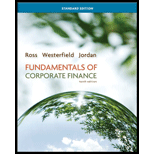
Concept explainers
a)
To compute: The payback period.
Introduction:
Capital budgeting is a process, where the business identifies and assesses potential investments or expenses that are larger in general.
a)
Answer to Problem 17QP
Explanation of Solution
Given information:
The cash flows for two mutually exclusive projects are considered. The cash flows if Project A are $45,000, $65,000, $65,000, $440,000 for Project A respectively for year 1, year 2, year 3, and year 4. Project A has an initial investment of $350,000. The cash flows of Project B are $24,000, $22,000, $19,500, and $14,600 respectively for year 1, year 2, year 3, and year 4. The initial investment of Project B is $50,000. The
Formula to compute the payback period of a project:
Compute the payback period of a project for Project A:
Hence, the payback period for Project A is 3.40 years.
Compute the payback period of a project for Project B:
Hence, the payback period for Project B is 2.21 years.
b)
To compute: The discounted payback period.
Introduction:
Capital budgeting is a process, where the business identifies and assesses potential investments or expenses that are larger in general.
b)
Answer to Problem 17QP
Explanation of Solution
Given information:
The cash flows for two mutually exclusive projects are considered. The cash flows if Project A are $45,000, $65,000, $65,000, $440,000 for Project A respectively for year 1, year 2, year 3, and year 4. Project A has an initial investment of $350,000. The cash flows of Project B are $24,000, $22,000, $19,500, and $14,600 respectively for year 1, year 2, year 3, and year 4. The initial investment of Project B is $50,000. The rate of return is 15%.
Table showing the calculation of discounted payback period for Project A:
| Year |
Net |
||
| Annual |
Today’s value (discounted) at 15% |
Accumulated |
|
1 |
$45,000 | $39,130.43
|
$39,130.43 |
| 2 | $65,000 | $49,149.34
|
$88,279.77 |
| 3 | $65,000 | $42,738.56
|
$131,018.33 |
| 4 | $440,000 | $251,571.43
|
$382,589.76 |
Formula to compute the discounted payback period:
By the end of year 3, the recovery amount will be shorter than the initial investment. In year 4, the recovery amount will be higher than initial investment. It means the discounted payback period will be in between year 3 and 4.
Calculate discounted payback period, if the initial cost is $455,000:
Hence, the discounted payback period for Project A is 3.57 years.
Table showing the calculation of discounted payback period for Project B:
| Year | Net Cash Inflows | ||
| Annual | Today’s value (discounted) at 11% |
Accumulated |
|
1 |
$24,000 | $20,869.57
|
$20,869.57 |
| 2 | $22,000 | $16,635.16
|
$37,504.73 |
| 3 | $19,500 | $12,821.57
|
$50,326.30 |
| 4 | $14,600 | $8,347.60
|
$58,673.90 |
Formula to calculate the discounted payback period for Project B, if the initial cost is $50,000:
By the end of year 2, the recovery amount will be shorter than the initial investment. In year 3, the recovery amount will be higher than initial investment. It means the discounted payback period will be in between year 2 and 3.
Calculate the discounted payback period for Project B, if initial cost is $50,000:
Hence, the discounted payback period for Project B is 2.25 years.
c)
To compute: The NPV (
Introduction:
Capital budgeting is a process, where the business identifies and assesses potential investments or expenses that are larger in general.
c)
Answer to Problem 17QP
Explanation of Solution
Given information:
The cash flows for two mutually exclusive projects are considered. The cash flows if Project A are $45,000, $65,000, $65,000, $440,000 for Project A respectively for year 1, year 2, year 3, and year 4. Project A has an initial investment of $350,000. The cash flows of Project B are $24,000, $22,000, $19,500, and $14,600 respectively for year 1, year 2, year 3, and year 4. The initial investment of Project B is $50,000. The rate of return is 15%.
Formula to calculate the NPV:
Calculate the NPV for Project A:
Hence, the NPV for Project A is $32,589.76.
Calculate the NPV for Project B:
Hence, the NPV for Project B is $8,673.9.
d)
To compute: The
Introduction:
Capital budgeting is a process, where the business identifies and assesses potential investments or expenses that are larger in general.
d)
Answer to Problem 17QP
Explanation of Solution
Given information:
The cash flows for two mutually exclusive projects are considered. The cash flows if Project A are $45,000, $65,000, $65,000, $440,000 for Project A respectively for year 1, year 2, year 3, and year 4. Project A has an initial investment of $350,000. The cash flows of Project B are $24,000, $22,000, $19,500, and $14,600 respectively for year 1, year 2, year 3, and year 4. The initial investment of Project B is $50,000. The rate of return is 15%.
Equation of IRR of Project A:
Compute IRR for Project A using a spreadsheet:
Step 1:

- Type the equation of NPV in H6 in the spreadsheet and consider the IRR value as H7
Step 2:

- Assume the IRRvalue as 10%
Step 3:
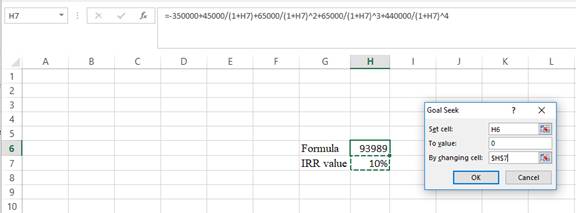
- In the spreadsheet, go to data and select What-If-Analysis
- In What-If-Analysis, select goal seek
- In set cell, select H6 (the formula)
- The “To value” is considered as 0 (the assumption value for NPV)
- The H7 cell is selected for the 'by changing cell'
Step 4:
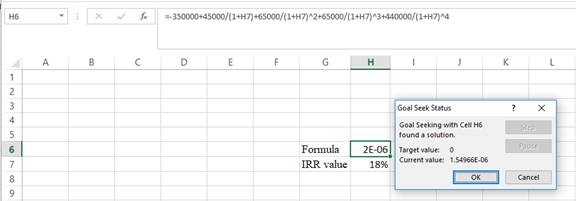
- Following the previous step, click OK in the goal seek status. The goal seek status appears with the IRRvalue
Step 5:
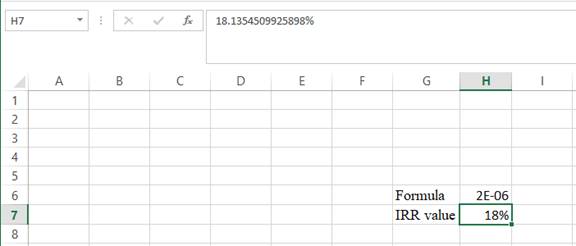
- Thevalue appears to be 18.1354509925898%.
Hence, the IRRvalue is 18.14%.
Equation of IRR of Project B:
Compute IRR for Project B using a spreadsheet:
Step 1:

- Type the equation of NPV in H6 in the spreadsheet, and consider the IRR value as H7
Step 2:

- Assume the IRRvalue as 10%
Step 3:
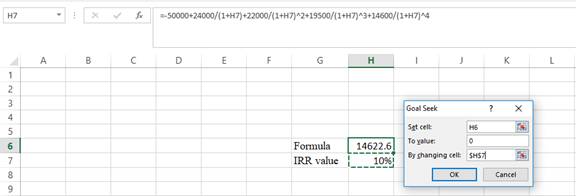
- In the spreadsheet go to data, and select What-If-Analysis
- In What-If-Analysis, select goal seek
- In set cell, select H6 (the formula)
- The “To value” is considered as 0 (the assumption value for NPV)
- The H7 cell is selected for the 'by changing cell'
Step 4:
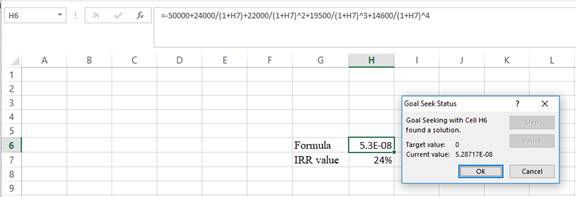
- Following the previous step, click 'OK' in the goal seek status. The goal seek status appears with the IRRvalue
Step 5:
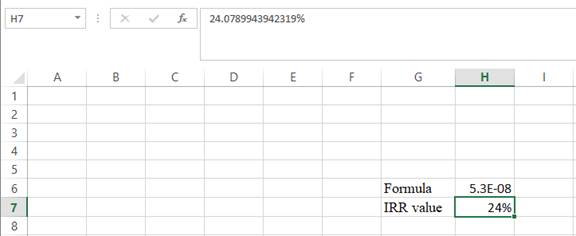
- Thevalue appears to be 24.0789943942319%.
Hence, the IRRvalue is 24%.
e)
To compute: The profitability index.
Introduction:
Capital budgeting is a process, where the business identifies and assesses potential investments or expenses that are larger in general.
e)
Answer to Problem 17QP
Explanation of Solution
Given information:
The cash flows for two mutually exclusive projects are considered. The cash flows if Project A are $45,000, $65,000, $65,000, $440,000 for Project A respectively for year 1, year 2, year 3, and year 4. Project A has an initial investment of $350,000. The cash flows of Project B are $24,000, $22,000, $19,500, and $14,600 respectively for year 1, year 2, year 3, and year 4. The initial investment of Project B is $50,000. The rate of return is 15%.
Formula to compute the profitability index:
Compute the profitability index for Project A:
Hence, the profitability index for Project A is $1.09.
Compute the profitability index for Project B:
Hence, the profitability index for Project B is $1.17.
f)
To discuss: The project that Person X will select with a reason.
Introduction:
Capital budgeting is a process, where the business identifies and assesses potential investments or expenses that are larger in general.
f)
Explanation of Solution
Given information:
The cash flows for two mutually exclusive projects are considered. The cash flows if Project A are $45,000, $65,000, $65,000, $440,000 for Project A respectively for year 1, year 2, year 3, and year 4. Project A has an initial investment of $350,000. The cash flows of Project B are $24,000, $22,000, $19,500, and $14,600 respectively for year 1, year 2, year 3, and year 4. The initial investment of Project B is $50,000. The rate of return is 15%.
Explanation:
In this case, the criteria of NPV denote that Project A must be accepted, while payback period, discounted payback, profitability index, and IRR denotes that Project B must be accepted. The overall decision must be based on the NPV as it does not have the ranking problem when compared with the other techniques of capital budgeting. Hence, Project A must be accepted.
Want to see more full solutions like this?
Chapter 9 Solutions
Fundamentals of Corporate Finance Standard Edition
- finance subjectarrow_forwardCould you help explain, what is the complete salary survey analysis, and ensuring the data is relevant and up-to-date? What is the job evaluation and compensation plan? How to ensure the final report is comprehensive, clearly structured, and aligned with the company vision?arrow_forwardThe maturity value of an $35,000 non-interest-bearing, simple discount 4%, 120-day note is:arrow_forward
- Carl Sonntag wanted to compare what proceeds he would receive with a simple interest note versus a simple discount note. Both had the same terms: $18,905 at 10% for 4 years. Use ordinary interest as needed. Calculate the simple interest note proceeds. Calculate the simple discount note proceeds.arrow_forwardWhat you're solving for Solving for maturity value, discount period, bank discount, and proceeds of a note. What's given in the problem Face value: $55300 Rate of interest: 10% Length of note: 95 days Date of note: August 23rd Date note discounted: September 18th Bank discount rate:9 percentarrow_forwardAll tutor giving incorrect solnarrow_forward
 Essentials Of InvestmentsFinanceISBN:9781260013924Author:Bodie, Zvi, Kane, Alex, MARCUS, Alan J.Publisher:Mcgraw-hill Education,
Essentials Of InvestmentsFinanceISBN:9781260013924Author:Bodie, Zvi, Kane, Alex, MARCUS, Alan J.Publisher:Mcgraw-hill Education,

 Foundations Of FinanceFinanceISBN:9780134897264Author:KEOWN, Arthur J., Martin, John D., PETTY, J. WilliamPublisher:Pearson,
Foundations Of FinanceFinanceISBN:9780134897264Author:KEOWN, Arthur J., Martin, John D., PETTY, J. WilliamPublisher:Pearson, Fundamentals of Financial Management (MindTap Cou...FinanceISBN:9781337395250Author:Eugene F. Brigham, Joel F. HoustonPublisher:Cengage Learning
Fundamentals of Financial Management (MindTap Cou...FinanceISBN:9781337395250Author:Eugene F. Brigham, Joel F. HoustonPublisher:Cengage Learning Corporate Finance (The Mcgraw-hill/Irwin Series i...FinanceISBN:9780077861759Author:Stephen A. Ross Franco Modigliani Professor of Financial Economics Professor, Randolph W Westerfield Robert R. Dockson Deans Chair in Bus. Admin., Jeffrey Jaffe, Bradford D Jordan ProfessorPublisher:McGraw-Hill Education
Corporate Finance (The Mcgraw-hill/Irwin Series i...FinanceISBN:9780077861759Author:Stephen A. Ross Franco Modigliani Professor of Financial Economics Professor, Randolph W Westerfield Robert R. Dockson Deans Chair in Bus. Admin., Jeffrey Jaffe, Bradford D Jordan ProfessorPublisher:McGraw-Hill Education





